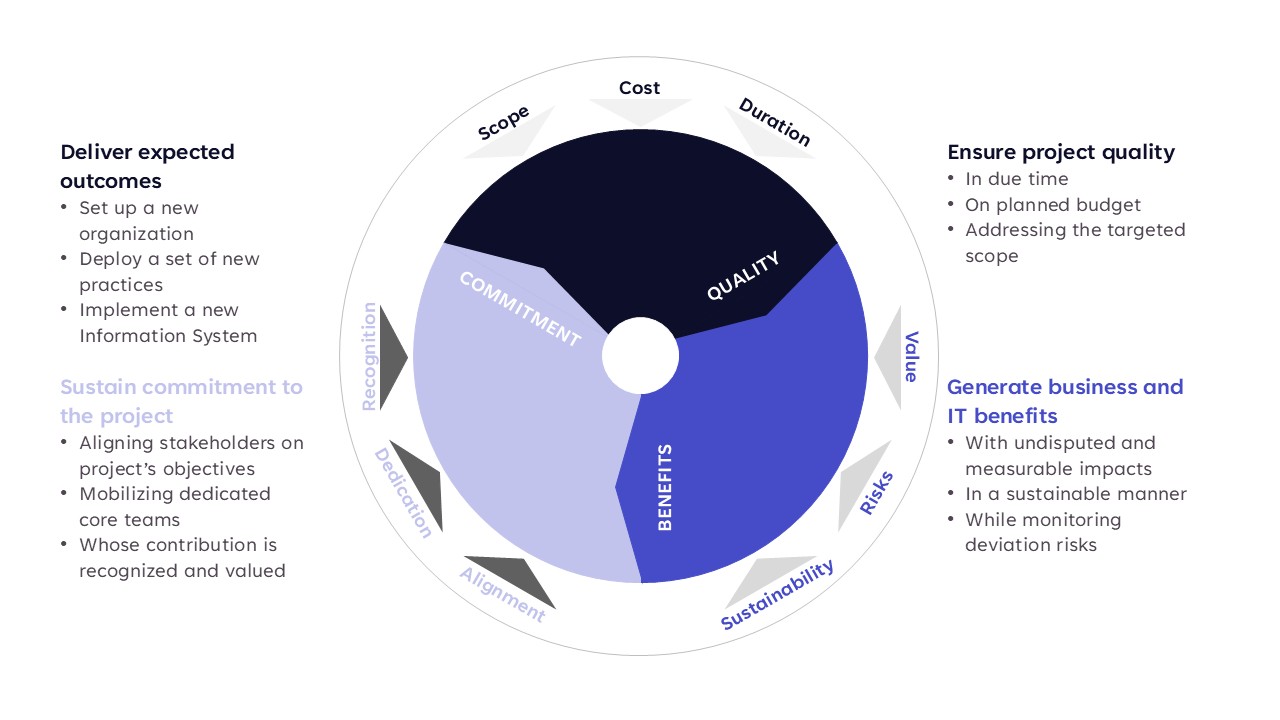Project Management
How to succeed in transformation while controlling the costs and schedule of your projects?
Recognize diversity of organizations and projects to succeed into IT powered transformation delivery
Companies have different types of realities, different levels of project management culture and different regulatory obligations contexts. These differences strongly influence how IT powered transformation projects shall be organized to ensure safe delivery of expected benefits. Every project is therefore particular and requires a differentiated approach combining different methodological frameworks and focusing on the human element in technology projects.

In 2021, the Project Management Institute reported that “58% of organizations fully understand the value of project management and 23% of organizations use standardized project management practices”. A survey published by the Harvard Business Review in 2020 found that IT projects overran their budget by a 27% average when at least one in six IT projects overran its cost with 200% and its schedule with 70%.
-
Ensure project quality
Quality is ultimately measured by the satisfaction of the requirements of customers, stakeholders and project sponsors. To get to this stage, a project plan was established, punctuated by the production of intermediate deliverables that contribute to the final delivery of the requirements. Throughout the project, a quality assurance process is set to check the adequacy of the intermediate deliverables with the predefined expectations. The quality assurance process focuses on defining the working method that will produce the deliverables in accordance with expectations. The quality assurance process then defines the method for deliverables acceptance to check their compliance. In this way, the addition of compliant intermediate results makes it possible to achieve the ultimate goal. It is generally recognized that quality of project final delivery is dependent from project scope, costs and duration management (project iron triangle).
Scope
An IT transformation project scope is detailed from ton all its functional, organizational and technical dimensions.
Defining project scope tightly, clearly identifying in and out of scope areas consists in decomposing:
- functional processes into variants and use cases,
- organizations into geographies, sites and departments,
- technical bill of materials into subproducts, modules and add-on packages.
Detailed project scope is organized into a robust and comprehensive Work Breakdown Structure. The Work Breakdown Structure is allotted into work packages. Work packages are structured around consistent chain of sequenced deliverables relating back to project scope and objectives.
Duration
Transformation project duration materializes the amount of time needed for the project to be completed successfully. The duration of the project can be constrained by a predefined and immutable project completion deadline. Project duration is strongly correlated to its critical path. The project critical path is a continuous string of critical activities in the project schedule between the Start and Finish of the project. The sum of the activity durations in the critical path is the minimal time required to deliver the project; therefore, a delay to any critical path activity will result in postponing the project completion date.
Cost
The cost of the transformation project depends on the amount of work and the level of investment required to achieve the project’s target outcome. The cost established in this way is the upper limit of the budget that can be spent to achieve the desired result.
Scope, cost and deadlines are interdependent, these three factors are linked in a defined and predictable way. Changing one or more of these factors requires an analysis of the reciprocal consequences on the other elements to reach a balanced compromise, while maintaining compliance with requirements.
-
Generate business and IT benefits
A business benefit is the value or utility created as a result of the successful completion of the transformation project. Project completion changes the business in a meaningful way delivering a target result, such as a new organization, new set of practices and / or a new information system. These results are exploited by end users. They will realize and / or appreciate the benefits derived from the results of the project.
Value
The value delivered by the project is thus tangible or intangible:
- when tangible, value is measured using objective methods and translated into numbers. The valued results can be used to assess the financial viability of the project: return on investment, net present value, internal rate of return, payback period, opportunity cost, etc.
- when intangible, the value of a project sometimes materializes the risk of not making it. This is often the case when a project consists of implementing a tool and / or a technological platform that will be used by other projects to create value (e.g. implementation of a datalake) or to avoid losing value (e.g. hedging a cyber risk).
Tangible or intangible, the value delivered by the project is the north of the project director’s compass. It is a fundamental decision-making tool: will the orientations taken during the project contribute to the achievement of the objectives and the creation of the expected value?
Risks
Achieving Project is subject to two necessary conditions:
- In quality delivery by the project of the expected results;
- Sustained exploitation by end-users of these results.
The project’s attention is rightly focused on the risks that weigh on the quality of the results’ delivery. Indeed, a low-quality result has little chance of being adopted in the long term and fully exploited by users. The project is generally able to identify these risks, prioritize them and deploy adequate mitigation plans.
The project can qualify part of the risks that threaten the exploitation of the results by users. The mitigation plans that the project implements focus on the adoption of the project’s results: communication, training, change management, etc. However, the responsibility for the adoption and sustainability of the results ultimately lies with the organizations that will use them. These organizations must take this critical responsibility in realizing the value delivered by the project.Sustainability
Monitoring benefits in a sustainable manner is a challenge for projects, especially due to:
- the time elapse between the launch of the project, its delivery and the realization of benefits;
- the segregation of responsibilities between the organization delivering the project and the one leveraging the project’s results to realize its value;
- the effectiveness of measuring project outcomes to show the link between benefits and business value.
The transformation project manager works to prepare a benefit sustainment plan to promote ongoing sustainment activities. A necessary condition for the success of this plan is the monitoring of the continued suitability of the capability delivered by the project and the preparation for its adoption. This is prepared during project execution and well before its completion.
Benefits realization must be formally checked against targets. Analyzing root causes of possible variances fosters continuous improvement through ongoing knowledge sharing, including lessons learned. In addition to knowledge transfer, extended support and assistance with transformation adoption may be needed. Field feedback on underperformance may also reveal the need for tweaking and / or improving the new capability in order to fully respond to customer expectations. This can be the case when some features were simplified and / or descoped in the course of the project.
-
Sustain commitment to the project
The quality of the final result of a project is directly correlated with the level of commitment of the teams assigned to it. The level of commitment depends on three factors: the alignment of stakeholders with the project objectives, the degree of dedication of the core teams to the project, and the recognition and appreciation of their contribution to the project.
A high level of commitment of the teams to the project objectives is a limiting factor in the turnover of the staff assigned to the project. This stability contributes to cost and time control by reducing the onboarding phases of replacement resources. The stability of the teams also minimizes the risk of losing knowledge on the project.
Alignment
Stakeholder alignment with the project’s goals translates into their stimulation for the project. Teams are motivated to carry out the project tasks for which they are responsible with the aim of contributing to the quality of the final result. Part-time project teams face an additional challenge: the execution of the project tasks for which they are responsible is competing with the operations in which the teams are otherwise involved. Their strong stimulation for the project limits the risk of cannibalizing their project time by operational time.
Dedication
The concomitance between project tasks and operational tasks can have other consequences for the part-time teams assigned to the project. By nature, project tasks suffer from a relative degree of predictability, as opposed to recurring tasks whose execution is controlled and organized. Part-time teams will certainly face an increase in their workload during the course of the project. This situation will require a trade-off of priorities between project and operations that will affect the quality of the project or operations, or failing that, expose teams to a risk of burnout in the long term. This is why it is often preferable to give priority to the assignment of full-time teams to the project when relevant. This organizational plan must include the question of the return to operations of the staff dedicated to the project. The project teams have generally been replaced in their operational positions and have acquired skills on the project that open up new perspectives for them. The staff dedicated full-time to the project must be subject to HR monitoring, one of the objectives of which will be to prepare for the return to operations.
Recognition
HR monitoring also consists of promoting and valuing the contribution of the teams assigned to the project to the achievement of its objectives. This is an important factor in the success of team engagement.
The proper execution of each unit task by teams operating in siloed swimming lanes is rarely sufficient to achieve the quality of a project’s results. It is difficult to taylorize all the tasks of a project. A project structurally involves a share of unforeseen events. The success of a project is linked to the collective response to deal with these unforeseen events. The seamless collaboration between the different teams (functional, technical, etc.) facilitates a proper mutual understanding of transverse problems that require a common response. The recognition system must integrate this notion of collective and transversality. In contrast, a recognition system that is too focused on individual performance bears a risk to that of the collective.

How we can help
-
Project Scoping
-
Project Management and Governance Deployment
-
Project Status / Gate Review
-
Project Quality Assurance
-
Project recovery
-
Project Management action training